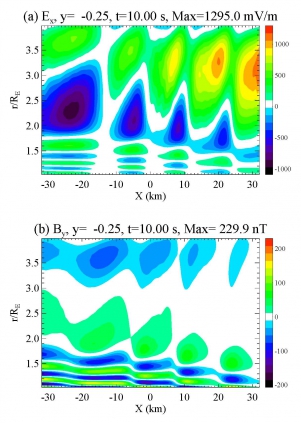Summary of Research Interests
- Theoretical space plasma physics, especially magnetospheric physics
- Auroral particle acceleration
- Dynamics of ultra-low-frequency (ULF) waves in the magnetosphere, especially kinetic Alfvén waves
- Magnetosphere-ionosphere coupling
- Dynamics of field-aligned currents
About My Work

(a) Electric and (b) magnetic field perturbations for a numerical model of waves trapped in the ionospheric Alfvén resonator (IAR) in an overall perpendicular density gradient. Interference between upgoing and downgoing waves leads to structuring of these waves, and the resonances of the IAR modes can be seen in the results (Lysak and Song, 2011).
My research emphasizes a fundamental theoretical understanding of the dynamics of plasmas in the Earth's magnetosphere, as well as in other planetary magnetospheres, the solar wind, and other astrophysical environments. I am particularly interested in the dynamics of the Earth's auroral regions. In these regions, strong currents flow along the magnetic field ("field-aligned currents") that are dissipated in the ionosphere and by accelerating the particles that produce the aurora. Changes in these current systems are mediated by waves called Alfvén waves, which correspond to transverse fluctuations of the geomagnetic field.
Although Alfvén waves were first studied using magnetohydrodynamic (MHD) theory, I have approached them using a more complete kinetic theory; thus, these waves are sometimes called kinetic Alfvén waves. Such waves can directly accelerate electrons into the ionosphere to produce the aurora. In addition, we are studying the ways in which these waves can evolve into quasi-static parallel electric fields that are known to be associated with discrete auroral arcs. These studies lead to an overall understanding of ultra-low-frequency (ULF) waves in the magnetosphere, especially the eigenmodes that can form due to the inhomogeneous nature of the magnetospheric plasma.
Parallel electric fields are also necessary for the process called magnetic reconnection, which refers to the reorganization of the magnetic topology in thin current sheets. We study the dynamics of these processes as well. ULF waves are also important in Jupiter's magnetosphere, where they are driven by the motion of Jupiter's moon Io. Alfvén waves may also be responsible for processes in the solar corona, such as solar flares, coronal mass ejections, and the heating of the corona to millions of degrees.
This work also benefits from collaboration with Senior Researcher Dr. Yan Song. Her work emphasizes the fundamental theory of particle acceleration and magnetic reconnection, emphasizing a dynamical approach that improves upon the quasi-steady descriptions often used to discuss these phenomena.